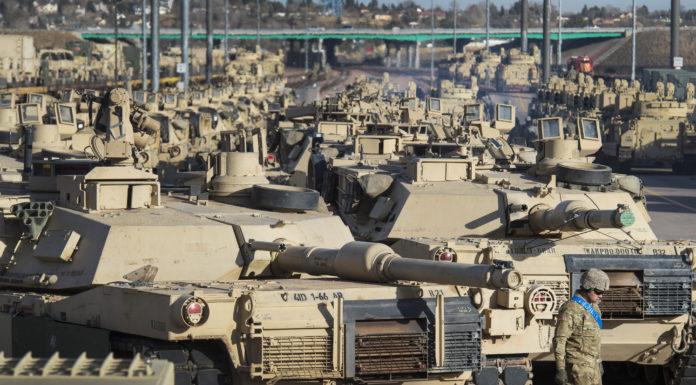(Headline USA) The Pentagon has overestimated the value of the weapons it has sent to Ukraine by at least $3 billion—an accounting error that could be a boon for the war effort because it will allow the Defense Department to send more weapons now without asking Congress for more money.
The acknowledgment Thursday comes at a time when Pentagon is under increased pressure by Congress to show accountability for the billions of dollars it has sent in weapons, ammunition and equipment to Ukraine and as some lawmakers question whether that level of support should continue.
As with many aspects of the Biden administration, it was unclear whether the true source of the mistake was intentional or if the “accidental” aspect of it was part of a deliberate ruse for the military to bypass their legal obligations and duties under the U.S. Constitution.
Either way, the bookkeeping blunder could free up more money for critical weapons as Ukraine is on the verge of a much anticipated counteroffensive—which will require as much military aid as they can get.
Ukrainian President Volodymyr Zelenskyy has previously said the offensive was delayed because they did not yet have everything they needed.
The “error” was caused when officials overvalued some of the systems sent to Ukraine, using the value of money it would cost to replace an item completely rather than the current value of the weapon. In many of the military aid packages, the Pentagon has opted to draw from its stockpiles of older, existing gear because it can get those items to Ukraine faster.
“During our regular oversight process of presidential drawdown packages, the Department discovered inconsistencies in equipment valuation for Ukraine. In some cases, ‘replacement cost’ rather than ‘net book value’ was used, therefore overestimating the value of the equipment drawn down from U.S. stocks,” said Pentagon spokeswoman Sabrina Singh.
She added that the “mistake” hasn’t constrained U.S. support to Ukraine or hampered the ability to send aid to the battlefield.
A defense official said the Pentagon is still trying to determine exactly how much the total surplus will be.
The official, who spoke on condition of anonymity to discuss internal deliberations, said the comptroller has asked the military services to review all previous Ukraine aid packages using the proper cost figures.
The result, said the official, will be that the department will have more available funding authority to use as the Ukraine offensive nears.
The aid surplus was first reported by the Wall Street Journal.
To date the U.S. has provided Ukraine nearly $37 billion in military aid since Russia invaded in February 2022, part of the more than $100 billion in aid that also includes discretionary funding to cover government operations such as salaries and pensions.
U.S. officials with the State Department have acknowledged that once the money leaves its hands, they are unable to account for how it is spent, with many suspecting widespread corruption by the Zelenskyy government.
In late February, the Pentagon’s inspector general said his office has found no evidence yet that any of the billions of dollars in weapons and aid to Ukraine has been lost to corruption or diverted into the wrong hands. He cautioned that those investigations are only in their early stages.
With regard to military aid, the bulk of it has been in weapons systems, millions of munitions and ammunition rounds, and an array of trucks, sensors, radars and other equipment pulled from Pentagon stockpiles and sent quickly to Ukraine.
Members of Congress have repeatedly pressed Defense Department leaders on how closely the U.S. is tracking its aid to Ukraine to ensure that it is not subject to fraud or ending up in the wrong hands.
The Pentagon has claimed it has a “robust program” to track the aid as it crosses the border into Ukraine and to keep tabs on it once it is there, depending on the sensitivity of each weapons system.
However, its failure to properly maintain its own bookkeeping accounts raises serious questions as to how it is able to hold Ukraine’s military accountable.
They have said that a small team of Americans in Ukraine working with Ukrainians to do physical inspections when possible, but also virtual inspections when needed, since those teams are not going to the front lines.
But even those operations have come under suspicion following a leak of files earlier this year that indicated there may already be U.S. boots on the ground.
At least one U.S. citizen appears to have been confirmed dead in Ukraine this week.
Retired Army Staff Sgt. Nicholas Maimer of Boise, Idaho, was killed during a barrage in Bakhmut, and his corpse, with American identification, was discovered by Russian forces who posted a video to Telegram.
“He was shooting back; he died in the battle, so we will hand over his documents tomorrow morning and pack everything, right?” said Russian oligarch Yevgeny Prigozhin in the video.
“… We’ll put him in a coffin, cover him with the American flag with respect because he did not die in his bed as a grandpa but he died at war and most likely a worthy [death], right?” Prigozhin added.
Maimer, a former Green Beret, ostensibly was working for a nonprofit group called AFGFree.
In addition to the known funding the U.S. has supplied to Ukraine, it remains unclear how much additional spending has come from the so-called black budget allocated to clandestine intelligence agencies.
Its existence was only confirmed publicly following another whistleblower leak, Edward Snowden’s 2013 disclosure. At the time, it amounted to $52.6 billion spread among the 16 intelligence agencies (including $14.7 million for the CIA) and an additional $23 billion for military intelligence programs.

